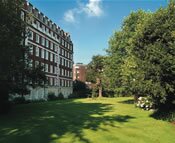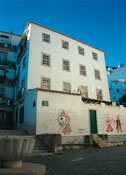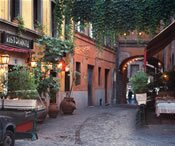Inflight Magazine of Brussels Airlines
Welcome to the Inflight Magazine of Brussels Airlines
Five alive
Give me 5
Europe’s capitals are exciting places to visit and invest in. Laura Latham picks fi ve of the best and examines what’s happening to their housing markets
Not all cities are created equal when it comes to desirability with investors. While property prices in London and Rome have romped into the record books, Lisbon and Berlin have been left to languish, while Madrid is on the slide. So should you be looking to invest in any of them right now?
London
 It’s easy to see why people have been saying London’s prices are heading for a fall, as the crazy increases seen over the past three years appear unsustainable. Overall price rises in the city have been around 20% per year, with prime property appreciating by 50% since 2006.
It’s easy to see why people have been saying London’s prices are heading for a fall, as the crazy increases seen over the past three years appear unsustainable. Overall price rises in the city have been around 20% per year, with prime property appreciating by 50% since 2006.
However, Stuart Law of property investment analyst Assetz believes there’s still room to grow. “I don’t see any way demand is going to reduce,” he says, citing the increasing numbers of wealthy overseas buyers who continue to target the city. Law claims property that was selling in prime areas such as Mayfair and Belgravia four years ago for around €590,000 (£400,000) now costs upwards of €1.2 million (£800,000), while property in areas such as Earls Court that cost around €350,000 (£250,000) three or four years ago now sells at twice that amount.
 As the effects of the price hikes ripple out to other areas, Law says the less wealthy will find themselves pushed out. He’s already seeing buyers taking an interest in locations such as Elephant and Castle and Putney, where prices – especially for new-build or conversion properties – are regarded as relatively affordable. However, this still means spending from around €430,000 (£300,000) for an apartment of any quality in a good street.
As the effects of the price hikes ripple out to other areas, Law says the less wealthy will find themselves pushed out. He’s already seeing buyers taking an interest in locations such as Elephant and Castle and Putney, where prices – especially for new-build or conversion properties – are regarded as relatively affordable. However, this still means spending from around €430,000 (£300,000) for an apartment of any quality in a good street.
Law believes increasing interest rates will only slow the market down to around 10% because demand is so high, so there’s still money to be made here. “Buyers are continuing to look for property in London, so investors haven’t missed the boat,” he says.
■ Assetz, tel. , www.assetz.co.uk
Lisbon
The Portuguese capital is often overlooked by buyers, yet has some of the prettiest architecture and lowest prices of any European city. There has been a lack of investment and much of the residential property has deteriorated, giving the city an air of decay. However, developers are moving in and the government is investing heavily in infrastructure, which indicates revitalisation could be on the cards.
Paul Houston of local agent Lucas Fox says prices have been depressed for some time, with rises struggling to reach 3% over the past few years. But he claims increased tourist numbers may mean more buyers. “We’ve seen a lot more visitors this year,” he says. “That interest trickles down into property as people come here and fall in love with the city. Plus, prices are competitive compared with other capitals.” According to Houston, average prices in the nicest areas of town range between €1,900 and €3,000 per m².
Carl Winning of IN’S agrees the market has been “very flat” but says there are still opportunities to buy. Properties on his books range from €125,000 for a studio measuring 50m² to around €280,000 for three-bedroom properties in more exclusive districts, such as Lapa. Paying €450,000 will get you a spacious and central home with great views. If predictions that Lisbon will be the next hot spot prove to be correct, the city could be one to watch.
■ Lucas Fox, tel. + 739, www.lucasfox.com
■ IN’S, , www.ins.pt
Berlin
 The German capital has been in recession for the past 15 years and prices are among the lowest in Europe. However, recent economic growth has given Germany a lift, consumer confidence has increased and buyers are taking a fresh look at the city. “Interest from foreign investors has picked up significantly in the past 12 months owing to the stabilisation of the German property market,” says Arik Agamian of property investment analyst Assetz.
The German capital has been in recession for the past 15 years and prices are among the lowest in Europe. However, recent economic growth has given Germany a lift, consumer confidence has increased and buyers are taking a fresh look at the city. “Interest from foreign investors has picked up significantly in the past 12 months owing to the stabilisation of the German property market,” says Arik Agamian of property investment analyst Assetz.
Prices per m² currently average around €1,800, even in sought-after areas such as Charlottenburg or Wilmersdorf, and it’s easy to find two-bedroom apartments from around €60,000. This has led speculators to move in, buying up whole blocks for renovation with a view to selling them on as prices rise.
Michel Hendrickx of Solid Rock Consultancy claims the best prospects can be found in areas such as Mitte, Prenzlauer Berg and Friedrichshain, where prices are as low as €43,000 for studios and €115,000 for three bedrooms “in a good area, within walking distance to everything”. He also advises buyers to look at areas undergoing regeneration, such as Alexanderplatz and Hellersdorf, where property can be found from as little as €50,000.
Prices in Berlin are expected to see steady growth in the next decade, offering good gains for early investors. The only word of caution is that much of the property comes with sitting tenants, who are protected rigorously by German law. However, this isn’t always a bad thing. As Hendrickx points out, at least your rental yields are guaranteed.
■ Solid Rock Consultancy, tel. , www.solidrockconsultancy.com
■ Assetz, tel. , www.assetz.co.uk
Madrid
 The Spanish capital has a reputation for being a party town and for four years property owners have been celebrating as prices jumped 12% or more per annum. However, 2007 saw a slowdown during which, according to Rita Fryer of The Property Finders, prices fell by 3%. “It’s turning into a buyer’s market,” she says.
The Spanish capital has a reputation for being a party town and for four years property owners have been celebrating as prices jumped 12% or more per annum. However, 2007 saw a slowdown during which, according to Rita Fryer of The Property Finders, prices fell by 3%. “It’s turning into a buyer’s market,” she says.
The main reason for the drop is a rise in mortgage interest rates, which has made buyers go cold on the city. This hasn’t made property cheap, though. Average prices in the upmarket district of Salamanca range from €7,000 to €12,000 per m², with Chueca costing on average €5,000 per m². Even areas such as the Barrio Alto, once considered quite seedy, are undergoing gentrification.
“The old town is very fashionable,” says Fryer. “So although there are pockets where property is cheap, that’s only compared with the expensive districts.” Fryer says it’s possible, at a push, to locate apartments in need of renovation for around €250,000, “but they’re getting harder to find”.
However, Fryer thinks buyers who discount Madrid are making a mistake because it still offers potential for capital and rental returns. She points out all the improvements promised in Madrid’s 2012 Olympic bid are still going ahead, which will make it an even better place to be. “It’s a dynamic and expanding city. Madrid is always going to be a good buy, no question about it.”
■ The Property Finders, tel. , www.thepropertyfinders.com
Rome
The eternal city has become highly sought after in the past 10 years, but don’t consider investing unless you have at least €500,000. And those who want a pied à terre near the Colosseum or Spanish Steps will have to fork out at least €800,000, according to property consultant Dominic Hebblethwaite of Live in Italy. “It’s ridiculous and very difficult for people to buy here now,” he says. “Most people want to be in the historic, central areas and there’s limited stock.”
Hebblethwaite claims that in once-cheap Trastevere you’ll be looking at upwards of €700,000 for a decent two-bedroom property. Even in outer areas, such as Testaccio or Monti, prices are around €500,000. In addition, such properties often won’t work as buy-tolet investments because they’re too far from the centre for tourists.
If you really want to own in Rome and can’t stretch your budget, Hebblethwaite recommends looking at Garbatella, an area with attractive 1920s architecture that is, by Rome standards, reasonably priced.
“It’s nice and you pay less,” he says. “Two-bedroom apartments can be found for upwards of €300,000.” It won’t give you a view of the Vatican, but with continuing price rises of 7% per year, it may be the only way you’ll get your foot in the door.
■ Live in Italy, tel. , www.live-in-italy.com
FR>> Affaires conclues
Nous avons passé en revue les capitales d’Europe les plus excitantes à visiter et où investir.
A Rome, impossible d’investir pour moins de €. Les quartiers plus excentrés comme Testaccio offrent des prix plus abordables mais les touristes ne veulent pas s’éloigner trop du centre. Le meilleur pari reste sans doute Garbatella, où les appartements deux chambres reviennent à € et augmentent de 7% par an.
A Lisbonne, l’immobilier résidentiel s’est détérioré à cause du manque d’investissements mais en ce moment le gouvernement investit massivement dans l’infrastructure. Les prix moyens, dans les quartiers de la ville les plus agréables, vont de €1900 à €3000 le mètre carré, ce qui fait de Lisbonne un futur point névralgique en Europe.
Après une répression de 15 ans, les prix de Berlin sont parmi les plus bas d’Europe mais le marché s’est récemment stabilisé. On trouvera les meilleures affaires dans les quartiers comme Mitte, Prenzlauer Berg et Friedrichshain, où les prix peuvent descendre jusqu’à €43 000 pour un studio et € pour un appartement trois chambres. Mais attention : les locataires sont rigoureusement protégés par la loi allemande.
Pendant quatre ans, les prix de Madrid ont augmenté de 12% chaque année mais 2007 a observé une baisse avec l’augmentation des intérêts. Ce n’est pas bon marché : les prix moyens dans le quartier très sélect de Salamanque vont de €7000 à €12 000 le mètre carré et sont à €5000 le mètre carré à Chueca.
Les prix londoniens peuvent paraître impossibles, l’immobilier de prestige ayant augmenté de 50% depuis 2006, mais la demande est encore forte. Quoi qu’il en soit, les acheteurs à plus petits budgets sont de plus en plus repoussés loin du centre, même si vous pouvez encore payer € (£) pour un appartement de n’importe quelle qualité dans une rue correcte.
NL>> Geef me de 5
We stellen voor: de vijf interessantste Europese hoofdsteden voor een bezoek en vastgoedinvestering.
Vergeet Rome als investering, tenzij je over minstens €500.000 beschikt. Buitenwijken zoals Testaccio bieden betere prijzen, maar toeristen zitten liever in het centrum. De beste keuze is wellicht Garbatella, waar huizen met twee slaapkamers te koop zijn voor €300.000 en jaarlijks zo’n 7% stijgen.
In Lissabon ging de kwaliteit van residentieel vastgoed erg achteruit door gebrek aan investeringen, maar de overheid investeert nu fors in infrastructuur. In de mooiste wijken van de stad betaal je gemiddeld tussen €1900 en €3000 per vierkante meter. Dit is duidelijk de volgende hotspot van Europa.
Na 15 jaar recessie zijn de prijzen in Berlijn de laagste in Europa, maar de markt is recent gestabiliseerd. Er zijn nog mogelijkheden in wijken als Mitte, Prenzlauer Berg en Friedrichshain, waar je een studio koopt vanaf €43.000 en een appartement met drie slaapkamers vanaf €115.000. Let wel op: huurders worden zeer goed beschermd door de Duitse wetgeving.
De voorbije 4 jaar stegen de prijzen in Madrid jaarlijks met 12%, maar in 2007 stagneerden ze door stijgende rentevoeten. Het is er niet goedkoop: de gemiddelde prijzen in de residentiële wijk van Salamanca liggen tussen €7000 en €12.000 per vierkante meter, terwijl Chueca gemiddeld €5000 kost.
In Londen lijken de huidige prijzen onhoudbaar. Topvastgoed werd sinds 2006 50% duurder, maar de vraag blijft hoog. Minder kapitaalkrachtige kopers zoeken hun heil buiten het centrum, maar ook daar kost een redelijk appartement in een leuke straat nog €430.000 (Ð300.000).
Leave a Reply
